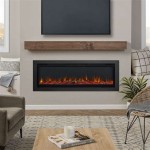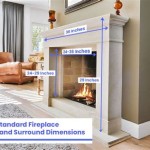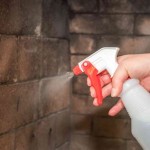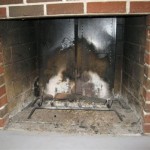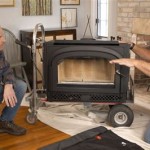Vented Gas Fireplace Inserts: A Comprehensive Overview
Vented gas fireplace inserts represent a popular and convenient heating solution for homeowners seeking to update existing masonry fireplaces or create a more aesthetically pleasing and efficient focal point in their living spaces. These inserts, designed to be installed directly into an existing fireplace opening, offer the ambiance of a traditional wood-burning fireplace without the associated mess, maintenance, and air quality concerns. Understanding the features, benefits, installation process, and maintenance requirements of vented gas fireplace inserts is crucial for making an informed decision about whether this heating option is suitable for a particular home and lifestyle.
The primary distinction between vented and ventless gas fireplace inserts lies in their exhaust systems. Vented models, the subject of this article, require a functional chimney or vent system to expel combustion byproducts, including carbon dioxide and water vapor, to the outside atmosphere. This venting requirement necessitates a properly sized and configured flue, ensuring safe and effective operation. In contrast, ventless models are designed to operate without a chimney, relying on advanced combustion technology and oxygen depletion sensors to minimize the release of harmful emissions into the living space. However, ventless models are often subject to stricter regulations and may not be permitted in certain jurisdictions due to concerns about indoor air quality.
Vented gas fireplace inserts offer a range of benefits over traditional wood-burning fireplaces. They provide instant heat with the flip of a switch or the push of a button, eliminating the need to gather, chop, and store firewood. The adjustable flame height and heat output allow for precise temperature control, ensuring a comfortable and energy-efficient heating experience. Furthermore, vented gas fireplace inserts produce significantly fewer emissions than wood-burning fireplaces, contributing to improved indoor and outdoor air quality. The reduced mess and maintenance associated with gas operation are also significant advantages, freeing homeowners from the chore of cleaning ash and soot.
Key Advantages of Vented Gas Fireplace Inserts
Vented gas fireplace inserts present several compelling advantages for homeowners looking to upgrade their fireplace experience. Their ease of use, efficiency, and environmental friendliness make them a popular alternative to traditional wood-burning systems.
Convenience and Ease of Use: One of the most significant advantages of vented gas fireplace inserts is their convenience. Unlike wood-burning fireplaces that require manual ignition, fuel preparation, and constant monitoring, gas inserts offer instant heat with the simple activation of a switch or remote control. This eliminates the need to purchase, store, and handle firewood, as well as the physical labor associated with building and maintaining a fire. Many models also come equipped with thermostatic controls, allowing homeowners to set a desired temperature and maintain a consistent level of warmth. This level of automation significantly reduces the effort required to enjoy the ambiance and warmth of a fireplace.
Improved Efficiency and Heat Output: Vented gas fireplace inserts are generally more efficient than traditional open-hearth wood-burning fireplaces. While open fireplaces lose a significant portion of their heat up the chimney, gas inserts are designed to maximize heat transfer into the living space. Modern vented gas inserts can achieve efficiencies ranging from 70% to 90%, meaning that a greater percentage of the energy consumed is converted into usable heat. This translates to lower energy bills and a more comfortable living environment. Furthermore, the adjustable flame height and heat output of gas inserts allow homeowners to fine-tune the heat level to their specific needs, preventing overheating and minimizing energy waste.
Enhanced Aesthetics and Design Options: Vented gas fireplace inserts are available in a wide variety of styles, finishes, and sizes, allowing homeowners to customize their fireplace to match their existing décor. From traditional log sets and brick liners to contemporary glass media and sleek metal surrounds, there are options to suit virtually any aesthetic preference. The realistic flame patterns and glowing embers of modern gas inserts mimic the look of a natural wood-burning fire, creating a warm and inviting atmosphere. Additionally, many models offer optional features such as remote controls, accent lighting, and programmable timers, further enhancing the overall fireplace experience.
Installation Considerations for Vented Gas Fireplace Inserts
Proper installation is paramount to the safe and efficient operation of a vented gas fireplace insert. Incorrect installation can lead to dangerous consequences, including gas leaks, carbon monoxide poisoning, and fire hazards. For these reasons, it is strongly recommended that installation be performed by a qualified and licensed professional.
Chimney Inspection and Preparation: Before installing a vented gas fireplace insert, a thorough inspection of the existing chimney is essential. The chimney must be structurally sound and free from cracks, blockages, or other damage that could compromise its ability to vent exhaust gases safely. In many cases, the existing chimney will need to be lined with a UL-listed chimney liner specifically designed for gas appliances. This liner helps to prevent the corrosion of the chimney masonry and ensures that the flue is properly sized and sealed. The liner typically extends from the insert connection point to the top of the chimney, providing a continuous pathway for combustion byproducts to escape. If the chimney is found to be in poor condition, repairs or even replacement may be necessary before the insert can be installed.
Gas Line Connection and Pressure Testing: Connecting the gas line to the insert requires meticulous attention to detail. A qualified technician will ensure that the gas line is properly sized and installed according to local codes and regulations. All connections must be leak-tested using a non-corrosive leak detection solution to ensure that there are no gas leaks. The gas pressure must also be checked to verify that it falls within the manufacturer's specified range. Insufficient gas pressure can result in a weak or unstable flame, while excessive pressure can damage the insert's components. A gas shut-off valve should be installed near the insert for easy access in case of emergency.
Insert Placement and Venting Configuration: The correct placement of the insert within the fireplace opening is crucial for proper venting. The insert must be installed according to the manufacturer's instructions, ensuring that there is adequate clearance around the unit for ventilation and maintenance. The venting configuration, including the connection to the chimney liner, must also be carefully planned and executed. Incorrect venting can lead to back drafting, where exhaust gases are drawn back into the living space, posing a serious health hazard. The venting system should be inspected annually to ensure that it remains free from obstructions and in good working order.
Maintenance and Safety of Vented Gas Fireplace Inserts
Regular maintenance is essential for ensuring the longevity, efficiency, and safety of a vented gas fireplace insert. Neglecting maintenance can lead to performance issues, safety hazards, and costly repairs. Adhering to a consistent maintenance schedule and following safety precautions is crucial for responsible ownership.
Annual Inspection and Cleaning: A professional inspection should be performed annually by a qualified technician. This inspection should include a thorough examination of the burner assembly, gas connections, venting system, and control components. The technician will clean the burner assembly to remove any accumulated debris, such as dust, lint, or spider webs, that could interfere with proper combustion. The venting system will be inspected for blockages or damage, and any necessary repairs will be made. Gas connections will be leak-tested to ensure that there are no gas leaks. The control components, including the pilot light, thermocouple, and gas valve, will be tested to ensure that they are functioning correctly.
Regular Cleaning and Upkeep: Homeowners can perform some basic cleaning and upkeep tasks to maintain their vented gas fireplace insert between professional inspections. The glass front should be cleaned regularly with a specifically designed glass cleaner to remove any soot or smudges. The area around the fireplace should be kept clear of combustible materials, such as curtains, furniture, and paper. The pilot light should be checked periodically to ensure that it is burning steadily and is not obstructed by debris. If the pilot light goes out, the manufacturer's instructions should be followed carefully to relight it safely.
Carbon Monoxide Detection and Prevention: Carbon monoxide (CO) is a colorless, odorless, and deadly gas that can be produced by incomplete combustion. It is imperative to install carbon monoxide detectors on every level of the home, especially near sleeping areas. These detectors should be tested regularly and replaced according to the manufacturer's instructions. If the carbon monoxide detector alarms, evacuate the home immediately and call the fire department or a qualified HVAC technician. Never ignore a carbon monoxide alarm. Ensure proper ventilation when operating the gas fireplace insert, and never block or obstruct the venting system. Educate all members of the household about the dangers of carbon monoxide poisoning and the importance of having working CO detectors.

Majestic 25 Inch Ruby Direct Vent Gas Fireplace Insert

Direct Vent Gas Insert With Intellifire Plus Ignition System Ipi Natural Nee Fireplaces

Majestic Ruby 35 Direct Vent Gas Insert Ruby35 North Country Fire

Rushmore 30 Direct Vent Fireplace Insert Fine S Gas
Understanding How Direct Vent Works Heat Glo

Freestanding High Efficiency Direct Vent Gas Fireplaces Inserts Stoves Godby Hearth And Home

Majestic 30 Inch Ruby Direct Vent Gas Fireplace Insert With Blower

Napoleon Ascent Dx42 Direct Vent Gas Burning Fireplace

Oakville Gdix4 Direct Vent Gas Fireplace Inset By Napoleon

Fireplaceinsert Com Kingsman Fireplace Insert Idv36
Related Posts



